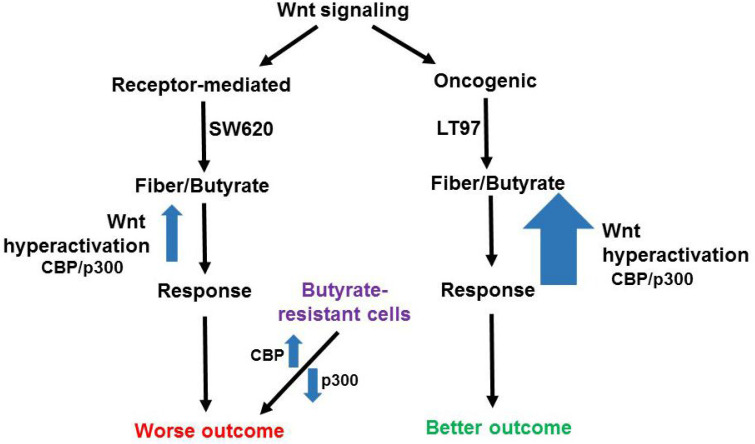Fig 1.
Potential effects of butyrate on oncogenic and receptor-mediated gene expression profiles in neoplastic colonic cells. Canonical Wnt signaling can be broadly divided between receptor-mediated Wnt signaling (left) and oncogenic Wnt signaling (right), activated by mutations in APC or beta-catenin. The former signaling is represented by a gene expression pattern more similar to that of the metastatic SW620 CRC cell line and results in a worse outcome for CRC patients, while the latter type of signaling is similar to that of LT97 adenoma cells and results in a better outcome in CRC. LT97 cells are more sensitive to the effects of butyrate, derived from dietary fiber, than are CRC cells. Thus, we posit that oncogenic Wnt signaling results, possibly mediated by CBP/p300, can be hyperactivated to a greater degree than receptor-mediated signaling, leading to a cell response (less proliferation and more apoptosis) associated with better outcomes. While the better outcomes for patients may be independent of Wnt modulation by butyrate, we note that physiological levels of butyrate in the colonic lumen reach and surpass that which can result in the aforementioned responses in cell culture. Therefore, it is possible that diet-derived butyrate affects the outcomes for patients with tumors with different Wnt signaling gene expression patterns. Butyrate-resistant cells have disrupted CBP-Wnt and p300-Wnt signaling and this results in worse outcomes independent of possessing a typical receptor-mediated Wnt signaling gene expression pattern. In this case, the loss of p300, and the consequent butyrate-resistance, obviates the requirement for other elements of a receptor-mediated molecular signature.

